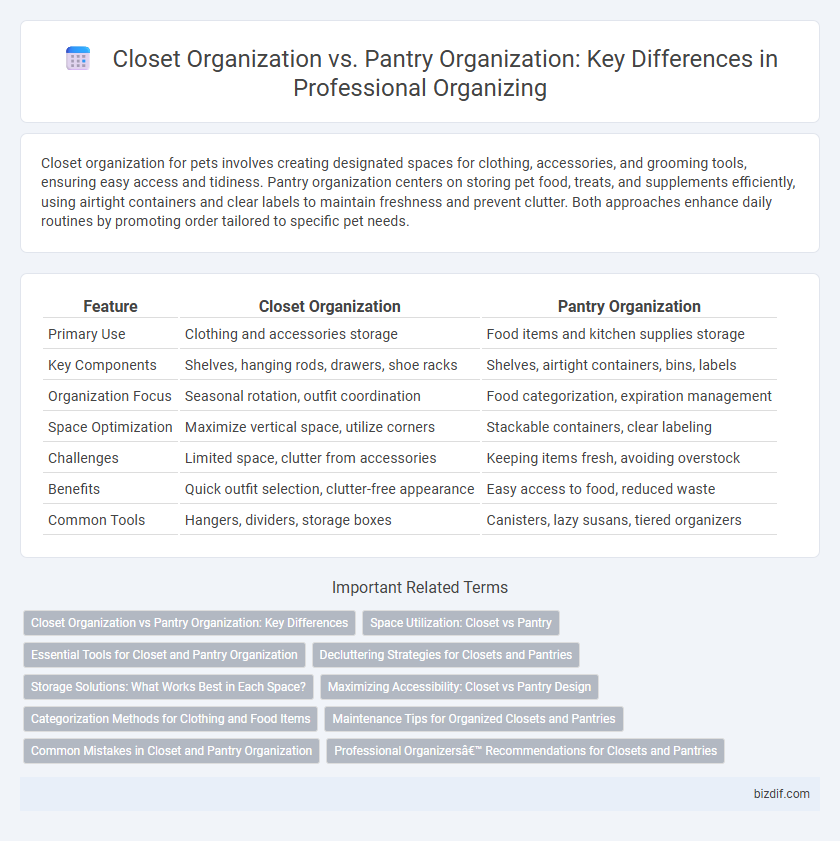Closet organization for pets involves creating designated spaces for clothing, accessories, and grooming tools, ensuring easy access and tidiness. Pantry organization centers on storing pet food, treats, and supplements efficiently, using airtight containers and clear labels to maintain freshness and prevent clutter. Both approaches enhance daily routines by promoting order tailored to specific pet needs.
Table of Comparison
| Feature | Closet Organization | Pantry Organization |
|---|---|---|
| Primary Use | Clothing and accessories storage | Food items and kitchen supplies storage |
| Key Components | Shelves, hanging rods, drawers, shoe racks | Shelves, airtight containers, bins, labels |
| Organization Focus | Seasonal rotation, outfit coordination | Food categorization, expiration management |
| Space Optimization | Maximize vertical space, utilize corners | Stackable containers, clear labeling |
| Challenges | Limited space, clutter from accessories | Keeping items fresh, avoiding overstock |
| Benefits | Quick outfit selection, clutter-free appearance | Easy access to food, reduced waste |
| Common Tools | Hangers, dividers, storage boxes | Canisters, lazy susans, tiered organizers |
Closet Organization vs Pantry Organization: Key Differences
Closet organization focuses on maximizing space for clothing, shoes, and accessories using hangers, shelves, and drawers designed for garments, while pantry organization involves categorizing food items, spices, and kitchen supplies with clear containers and labels to enhance accessibility and freshness. Closets often require solutions for varying item sizes and fabrics, whereas pantries emphasize expiration date management and preventing contamination. Both require tailored strategies to improve usability and maintain order, but their distinct contents demand specialized tools and layouts.
Space Utilization: Closet vs Pantry
Closet organization maximizes vertical space by incorporating shelves, hanging rods, and adjustable compartments tailored for clothing and accessories, enhancing accessibility and visibility. Pantry organization optimizes horizontal and vertical storage with clear containers, tiered shelving, and stackable bins designed to accommodate varied food items and kitchen supplies efficiently. Both approaches prioritize space utilization by customizing configurations to the specific types of items stored, ensuring clutter-free, easily navigable areas.
Essential Tools for Closet and Pantry Organization
Essential tools for closet organization include adjustable shelving, uniform hangers, stackable bins, and drawer dividers, which maximize space and accessibility while keeping clothing and accessories neatly categorized. Pantry organization relies on airtight containers, tiered shelves, labeled baskets, and lazy Susans to maintain freshness, optimize storage, and ensure easy retrieval of food items. Both closet and pantry setups benefit from clear labeling systems and modular components that enhance functionality and maintain order efficiently.
Decluttering Strategies for Closets and Pantries
Effective decluttering strategies for closets involve categorizing items by frequency of use and season, discarding or donating rarely worn clothes, and utilizing uniform storage solutions to maximize space. Pantry organization requires grouping food items by type, checking expiration dates regularly, and using clear, labeled containers to maintain visibility and prevent waste. Both spaces benefit from routine assessments to ensure functionality and maintain order over time.
Storage Solutions: What Works Best in Each Space?
Closet organization thrives with adjustable shelving, hanging systems, and modular drawers tailored for clothing, shoes, and accessories, maximizing vertical space and easy access. Pantry organization benefits from clear, stackable containers, labeled bins, and pull-out shelves that optimize visibility and preserve food freshness. Both spaces require customized storage solutions that address specific usage patterns and spatial constraints for optimal functionality.
Maximizing Accessibility: Closet vs Pantry Design
Maximizing accessibility in closet organization involves using adjustable shelving, clear bins, and labeled compartments to ensure easy retrieval of clothing and accessories. Pantry design emphasizes tiered shelving, transparent containers, and strategic grouping of items to facilitate quick identification and access to food products. Both spaces benefit from thoughtful layout planning that prioritizes visibility and reachability tailored to their specific storage needs.
Categorization Methods for Clothing and Food Items
Closet organization relies heavily on categorization methods such as sorting clothing by type, color, season, and frequency of use to maximize accessibility and space efficiency. Pantry organization prioritizes grouping food items based on categories like expiration dates, food type (canned goods, grains, spices), and usage frequency to reduce waste and streamline meal preparation. Both systems benefit from clear labeling, uniform storage containers, and strategic placement to enhance visibility and ease of access.
Maintenance Tips for Organized Closets and Pantries
Maintaining an organized closet requires regular decluttering, using uniform hangers, and implementing labeled storage bins to maximize space efficiency and ease of access. For pantries, periodic inventory checks, airtight containers to preserve food freshness, and tiered shelving help sustain order and prevent spoilage. Both spaces benefit from consistent cleaning routines and strategic placement to enhance functionality and streamline daily routines.
Common Mistakes in Closet and Pantry Organization
Common mistakes in closet organization include overcrowding, lack of categorization, and poor use of vertical space, leading to cluttered and inaccessible storage. In pantry organization, improper labeling, ignoring expiration dates, and inconsistent container sizing result in wasted food and inefficient use of space. Both require tailored strategies that emphasize clear categorization, visibility, and maintenance to optimize functionality.
Professional Organizers’ Recommendations for Closets and Pantries
Professional organizers emphasize tailored strategies for closet and pantry organization to maximize space and enhance accessibility. Closets benefit from segmented zones for clothing types, adjustable shelving, and clear storage bins, while pantries require airtight containers, labeled shelves, and categorized groupings for dry goods, canned items, and spices. Utilizing vertical space and incorporating inventory rotation systems are key recommendations for both areas to maintain order and efficiency.
closet organization vs pantry organization Infographic

 bizdif.com
bizdif.com